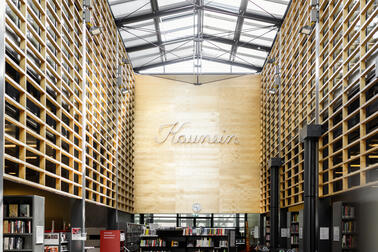
Helping children and young people feel safer in their neighbourhood and like they are part of the community.
That is the core of what the city is working towards in the development programme of the Bloomberg Philanthropies Foundation and Harvard University (City Collaboration Track 2022–2023). Helsinki was selected for the international programme along with nine other cities.
Although Helsinki is one of the safest cities in the world, children and young people are increasingly experiencing insecurity. There are also differences in the feelings of insecurity in different Helsinki districts.
When Helsinki was offered the opportunity to participate in a programme funded by the foundation and the university, the city wanted to seek solutions for preventive work and to develop operating models for addressing problems.
The district chosen was the urban renewal area of Kannelmäki. In urban renewal areas, special attention is paid to the comfort of residents by renovating residential areas and building new ones. This also prevents segregation.
Meri Virta, Development Consultant at the City of Helsinki, says that the challenges of Kannelmäki can also be found in different parts of Helsinki. The aim is to disseminate the experience and lessons learned in Kannelmäki to other Helsinki districts, in particular urban renewal areas.
The programme got under way at the beginning of the year, but it has already yielded results.

Disruptive behaviour under control
When the reasons for the experiences of insecurity were investigated, children and young people mentioned “disruptive groups of boys” as one of the reasons.
Disruptive behaviour also arises from public drunkenness.
When experiences of insecurity were discussed in a group, it was noticed that there were complex and difficult patterns in the background.
From the beginning, it was clear that complex situations require the work of many actors and close cooperation, in particular.
Cooperation between schools, youth work and the police has already been successfully increased. Of course, there has been cooperation in the past, but now all parties, including their upper management, are aware of the situation in the field and are committed to finding solutions.
Among the measures launched are safety walks for children and young people, where the group discusses which places are unsafe or dangerous and how they could be made safer and more comfortable. Attention is also paid to safe and comfortable places and what makes them so.
Children and young people have also had safety workshops. Among other things, they have expressed their wishes on how the Sitra square in Kannelmäki should be renovated.
Special intervention models have been used for young people who act out through crime.
Morning coffee dates with families and other low-threshold events have been increased. Cooperation between the school and parents are also being strengthened in learning discussions.
Immigrant mothers are starting gatherings at the school, where they are offered language and mathematics studies as part of integration support. This also familiarises them with the school environment.

Breaking problems into manageable pieces
Chief Inspector Katja Nissinen, who is part of the programme’s core group, praises the regional operating model created during the spring.
“Solving challenging and complex regional security problems is part of my job. In police activities, we look at what we can do preventively and, on the other hand, we consider who could be the best partners for cooperation.
“During the spring, help has been provided for the involvement of others, as knowledge of common challenges has spread and solutions have been sought with various experts and actors.”
Nissinen thinks it is great that the programme has forced people to think about the problem – the experience of insecurity – step by step, without going directly to the expected outcome. The problem had many small parts and, therefore, the number of actors who were managing them and knew about them also grew.
The core group consists of supervisors who have gained a good grasp of the complexity of situations and increased their understanding of the work and opportunities of other actors. In Nissinen’s opinion, it is important that all actors, including top management, are now committed to solving the problems.
Eradicating the silo mentality
Meri Virta is pleased with the wide range of stakeholders. The programme has also benefited from the fresh knowledge of researchers. Close cooperation with the local residents, especially children and young people, has been extremely important. Special attention was paid to those aged 9 to 13.
Smooth cooperation with immigrant groups has been emphasised, with reminders of how every service in the city must also serve integration.
Thanks to the programme, experts in different fields have gotten to know each other and now know who to contact when they notice a need for a joint response and action.
“The aim is not to look at whose budget or resource something will come out of, but rather at how the situation can best be resolved. Like the other participants, she wants to end the silo mentality of the city organisation in order to find solutions to complex situations together.”
Hanna Harris, Chief Design Officer, points out that the user-centred and human-centred approach have been taken seriously in the work done this spring.
“We have repeatedly asked and questioned whether we have sufficiently identified the problem together with children, young people and families as well as those who work with them.”
She emphasises the information has been produced and compiled. At the same time, efforts have been made to strengthen the mechanisms for where and how information is systematically processed.
It has also been essential to raise the neighbourhood’s perspective to a different level of dialogue.

Active listening of residents
Arjariitta Heikkinen, Basic Education District Manager, considers it important that, in addition to deeper cooperation, more active use has been made of good but hidden structures. Children’s and young people’s days become safer and more cohesive when several actors participate in their structuring.
New forms of interaction with families have been discovered. Participatory morning coffee dates have been useful, as have private one-to-one discussions with parents. They have been actively asked how they want to participate in their children’s lives and schooling.
“The experience of security builds on the foundation of the experience of inclusion. We must be able to build trust and mutual respect between each other.”
Tiina Hörkkö, Youth Services District Manager, mentions a website of the Kannelmäki district’s leisure activities being piloted as an example of concrete achievements. Associations are helping the city compile tips for leisure activities for the website.
She is particularly pleased that children and young people have now been made the focus and that cooperation has been intensified specifically for them.
“We have learned that people in different organisations can talk to each other about phenomena and issues without violating confidentiality. This, too, contributes to working together.”
Hörkkö says that it has also been a great leap forward to understand the importance of management, nurturing, monitoring and measuring in the development of security in the area.
Essential regional work
Satu Järvenkallas, Head of Education Division, explains how important it is to make regional work visible. During the spring, they understood how many different perspectives children’s and young people’s issues need to be examined and how poorly an organisation with silo mentality functions in complex situations.
In her opinion, the new regional model is worth presenting to others. She hopes that the work will progress and that more people can be trained to participate in the network’s collaboration activities.
Mari Väistö, Chief Nursing Officer of school health care, points out that Kannelmäki, like in Helsinki in general, is home to families that are well but also those that are struggling. Some families need support, the forms of which they have now been able to analyse, plan and develop with a large group of experts.
In addition to the eight members of the core group, several dozen participants from different fields have contributed.
In her opinion, it is wonderful how the knowledge and understanding of divergent school development has deepened as well as the view that student welfare requires the closer involvement of public health nurses.
She points out that resolving the concerns of families and the situations that burden them takes time. Thanks to the work that has now been started, the matters that concern families will be brought to the attention of an ever larger number of people, including supervisors. This makes it easier to justify rapid intervention and the need for resources in the field.
Piia Pelimanni, Project Manager, highlights the discussions that have been held with children and young people since the beginning of the programme. They have been able to share what is nice in the neighbourhood and what they are worried about.
It has been good for children and young people as well as the local residents, in general, to see the new development that has started in Kannelmäki as an urban renewal area.
Pelimanni thinks that the new common regional model will help prevent escalating situations. When something happens, it is heard that some professionals predicted the negative development two or three years earlier.
Now, such predictions are shared quickly with a wide audience.
Meri Virta points out that, although the list of achievements is long, the work is still in its early stages.
“At the end of the programme, we will certainly not just say goodbye to the residents! The interaction must be active. It is not the city that defines the agenda but rather the residents themselves. The aim is to strengthen the sense of community,” says Meri Virta.


